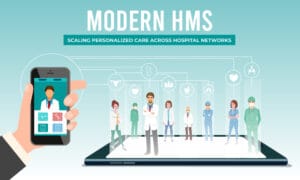
Are you considering purchasing a laboratory management system software for your hospital or diagnostic center? If you are, you have come to the ideal spot since we are here to assist you in selecting the best LIMS / LIS for your facility’s needs.
Without a doubt, laboratory management system software has grown to be one of the most important technologies in any hospital looking to improve workflow management and offer patients services.
What is a Laboratory Management System Software and Why Do You Need One?
Labs routinely log, track, record, and dispatch reports on sample and pathology data using a laboratory information management system (LIMS). While testing abilities associated to quality assurance as well as quality processes have grown with technology, the core job of the LIMS has stayed the same: the lab must audit a sample from creation to release, consumption, and disposal.
Laboratory management system software allows for exact tracking, assisting labs in adhering to industry best practices such as NABL. The system collects certain data automatically, reducing the amount of time spent manually logging samples and allowing them to spend more time optimizing their procedures for accuracy and effectiveness for more dependable findings.
Your lab may handle samples and related data, integrate instruments, and automate operations by using LIMS. Also, you can boost efficiency by tracking data from sequencing runs across time and between studies and producing trustworthy results more quickly.
Features to Look Upon
The configuration of laboratory management system software depends on the specific needs of different medical businesses. You need these components to make a lab management system work:
- Patient Registration
- Billing
- Queue Management
- Sample Collection
- Barcode Generation
- Sample Routing
- Processing
- Reporting
- QC Approval
- Dispatch
- Reports
- Analytics
Tracking of samples
One of the most important features of a laboratory information management system. This feature fully automates the tracking of samples while they move through the laboratory and between departments. This feature provides a digital trail by assigning unique identifiers, leaving no opportunity for human error.
Workflow Management
Standardized procedures for all tests will be included in this feature. Another significant step towards automation, it also notifies you about the many kinds of tests, their outcomes, the progress of the validation, and so forth.
Data Storage & Privacy
Implementing appropriate data storage techniques is vital for any laboratory information management system. Personally identifiable data should be kept away from test findings, and security criteria must be satisfied to prevent leaks. Also, you need access that is swift, dependable, and uninterrupted so as to avoid interfering with your lab’s operations.
Additionally ask these questions to the vendor regarding Data security-
- What mechanism(s) does the LIMS employ to authenticate system users?
- How frequently does the system ask you to change your password? Is the system capable of encrypting passwords? Is there a standard format?
- How is access managed if the LIMS has an external gateway for external user access?
- The LIMS restricts user access to functionality, menus, reports, exports, and workflows in what ways? How simple is it to change this?
- Is data encrypted in the LIMS?
- Is it possible to add additional fields and encrypt them in the LIMS? How does this work? Are there any limitations?
- Will the LIMS provide rule-based data encryption and decryption? How is this organized and managed?
- What data transfer techniques and protocols are supported by the LIMS?
Inventory and equipment management
To avoid delays, keep your lab well-stocked with test materials and reagents. When restocking is due, the software can send out automatic alerts. Your laboratory information management system can also monitor the status of your equipment and send out maintenance requests as needed.
Reporting and Analytics
This feature will enable you to minimize physical labor and increase your lab’s efficiency. Export your data and distribute it to within departments or external customers that ordered the tests. Employ advanced analytics to mine your information for insights on medical problems, demographics, or the costs of your institution.
Compliance Management
The healthcare industry is extensively regulated, making it difficult to keep track of every requirement. Avoid legal issues by implementing a lab management system with built-in compliance capabilities – and keeping them up to date.
Evaluate Your Requirement & Needs
An important factor when selecting a laboratory information system (LIMS) for your lab is determining what current processes are causing a barrier to reaching regulatory standards and where increased efficiency are costing you time and money.
Criteria should also include comparing:
Features
Compare characteristics such as onsite installation versus a cloud-based system and if the software is suitable for purpose when selecting a laboratory information management system vendor.
Evaluate the dashboard’s usefulness and how efficient the workflows are. Vendor Credibility
Sample management is critical, as is data reporting and visualization.
Pricing
An effective quality management system that supports the execution of quality improvements is put in place with the aid of a reliable laboratory information management system provider.
Consider license fees versus a subscription-based price when evaluating pricing, having in mind that with subscriptions, future updates may be simply included.
A subscription-based LIMS solution saves time and money while providing industry-leading functionality.
Support
Consider what continuing support is required in addition to setting up expenditures. You must guarantee that your laboratory information management system partner can see you through the installation procedure and provide the degree of assistance you require after launch.
Implementation Timeline
There is a significant difference in implementation time between a tailored configuration and an out-of-the-box solution. Evaluate any future updates contained in the bundle that are maintained by the vendor rather than internal IT projects.
Vendor Credibility and Profiling
Partnering with a laboratory information management system vendor who has substantial industry knowledge will help you save time on designing, installing, and evaluating your system. When you work with them, experienced suppliers will have dealt with similar lab setups and can propose best practices. It is beneficial to question vendors for any necessary credentials that validate their years of experience in the field.
The Benefits of Implementing Ezovion LIMS Software
Ezovion Laboratory Information System provides numerous benefits that help partner labs become more competitive and future ready. LIMS Systems are very adaptable and can be tailored to your specific requirements.
- Allow workflow automation to eliminate human errors and save time.
- From the lab machine, upload data directly to the lab module within EMR.
- centralize data access and storage while also improving test result accuracy.
- Errors in manual sample collecting should be avoided.
- Reagent inventory is automatically maintained.
- Integration with lab orders and billing
- Contributes to NABL certification Improves patient engagement and safety
- Online access to laboratory findings is available to patients.
Conclusion:
Ezovion (LIMS) laboratory information management system is an on-premises and cloud-based system that automates and manages several critical workflows in your laboratory. From registration to test results, a complete and dependable solution manages everything, increasing your revenue while saving you time and money.

Are you considering purchasing a laboratory management system software for your hospital or diagnostic center? If you are, you have come to the ideal spot since we are here to assist you in selecting the best LIMS / LIS for your facility’s needs.
Without a doubt, laboratory management system software has grown to be one of the most important technologies in any hospital looking to improve workflow management and offer patients services.
What is a Laboratory Management System Software and Why Do You Need One?
Labs routinely log, track, record, and dispatch reports on sample and pathology data using a laboratory information management system (LIMS). While testing abilities associated to quality assurance as well as quality processes have grown with technology, the core job of the LIMS has stayed the same: the lab must audit a sample from creation to release, consumption, and disposal.
Laboratory management system software allows for exact tracking, assisting labs in adhering to industry best practices such as NABL. The system collects certain data automatically, reducing the amount of time spent manually logging samples and allowing them to spend more time optimizing their procedures for accuracy and effectiveness for more dependable findings.
Your lab may handle samples and related data, integrate instruments, and automate operations by using LIMS. Also, you can boost efficiency by tracking data from sequencing runs across time and between studies and producing trustworthy results more quickly.
Features to Look Upon
The configuration of laboratory management system software depends on the specific needs of different medical businesses. You need these components to make a lab management system work:
- Patient Registration
- Billing
- Queue Management
- Sample Collection
- Barcode Generation
- Sample Routing
- Processing
- Reporting
- QC Approval
- Dispatch
- Reports
- Analytics
Tracking of samples
One of the most important features of a laboratory information management system. This feature fully automates the tracking of samples while they move through the laboratory and between departments. This feature provides a digital trail by assigning unique identifiers, leaving no opportunity for human error.
Workflow Management
Standardized procedures for all tests will be included in this feature. Another significant step towards automation, it also notifies you about the many kinds of tests, their outcomes, the progress of the validation, and so forth.
Data Storage & Privacy
Implementing appropriate data storage techniques is vital for any laboratory information management system. Personally identifiable data should be kept away from test findings, and security criteria must be satisfied to prevent leaks. Also, you need access that is swift, dependable, and uninterrupted so as to avoid interfering with your lab’s operations.
Additionally ask these questions to the vendor regarding Data security-
- What mechanism(s) does the LIMS employ to authenticate system users?
- How frequently does the system ask you to change your password? Is the system capable of encrypting passwords? Is there a standard format?
- How is access managed if the LIMS has an external gateway for external user access?
- The LIMS restricts user access to functionality, menus, reports, exports, and workflows in what ways? How simple is it to change this?
- Is data encrypted in the LIMS?
- Is it possible to add additional fields and encrypt them in the LIMS? How does this work? Are there any limitations?
- Will the LIMS provide rule-based data encryption and decryption? How is this organized and managed?
- What data transfer techniques and protocols are supported by the LIMS?
Inventory and equipment management
To avoid delays, keep your lab well-stocked with test materials and reagents. When restocking is due, the software can send out automatic alerts. Your laboratory information management system can also monitor the status of your equipment and send out maintenance requests as needed.
Reporting and Analytics
This feature will enable you to minimize physical labor and increase your lab’s efficiency. Export your data and distribute it to within departments or external customers that ordered the tests. Employ advanced analytics to mine your information for insights on medical problems, demographics, or the costs of your institution.
Compliance Management
The healthcare industry is extensively regulated, making it difficult to keep track of every requirement. Avoid legal issues by implementing a lab management system with built-in compliance capabilities – and keeping them up to date.
Evaluate Your Requirement & Needs
An important factor when selecting a laboratory information system (LIMS) for your lab is determining what current processes are causing a barrier to reaching regulatory standards and where increased efficiency are costing you time and money.
Criteria should also include comparing:
Features
Compare characteristics such as onsite installation versus a cloud-based system and if the software is suitable for purpose when selecting a laboratory information management system vendor.
Evaluate the dashboard’s usefulness and how efficient the workflows are. Vendor Credibility
Sample management is critical, as is data reporting and visualization.
Pricing
An effective quality management system that supports the execution of quality improvements is put in place with the aid of a reliable laboratory information management system provider.
Consider license fees versus a subscription-based price when evaluating pricing, having in mind that with subscriptions, future updates may be simply included.
A subscription-based LIMS solution saves time and money while providing industry-leading functionality.
Support
Consider what continuing support is required in addition to setting up expenditures. You must guarantee that your laboratory information management system partner can see you through the installation procedure and provide the degree of assistance you require after launch.
Implementation Timeline
There is a significant difference in implementation time between a tailored configuration and an out-of-the-box solution. Evaluate any future updates contained in the bundle that are maintained by the vendor rather than internal IT projects.
Vendor Credibility and Profiling
Partnering with a laboratory information management system vendor who has substantial industry knowledge will help you save time on designing, installing, and evaluating your system. When you work with them, experienced suppliers will have dealt with similar lab setups and can propose best practices. It is beneficial to question vendors for any necessary credentials that validate their years of experience in the field.
The Benefits of Implementing Ezovion LIMS Software
Ezovion Laboratory Information System provides numerous benefits that help partner labs become more competitive and future ready. LIMS Systems are very adaptable and can be tailored to your specific requirements.
- Allow workflow automation to eliminate human errors and save time.
- From the lab machine, upload data directly to the lab module within EMR.
- centralize data access and storage while also improving test result accuracy.
- Errors in manual sample collecting should be avoided.
- Reagent inventory is automatically maintained.
- Integration with lab orders and billing
- Contributes to NABL certification Improves patient engagement and safety
- Online access to laboratory findings is available to patients.
Conclusion:
Ezovion (LIMS) laboratory information management system is an on-premises and cloud-based system that automates and manages several critical workflows in your laboratory. From registration to test results, a complete and dependable solution manages everything, increasing your revenue while saving you time and money.





